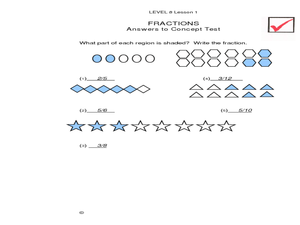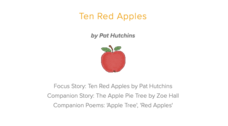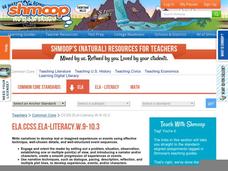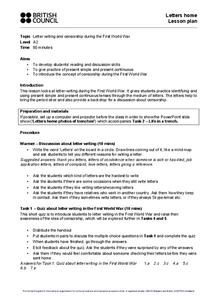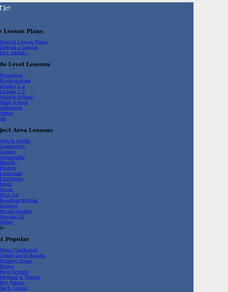Curated OER
Fraction Games
Explore fractions with upper graders. They will discover how to show fractions by shading the correct amount shown in a picture (giving them the idea behind part to whole). They also play multiple fraction games using dice, matching...
Curated OER
Ten Red Apples; The Five Senses
A clever lesson designed around an apple awaits your learners. Descriptive words are used to explain what they believe is inside a bag while using their five senses. Students read the story The Apple Pie Tree and are introduced to the...
Curated OER
Sign of the Beaver
This well-designed presentation serves as an excellent test review for students who have just read the book "Sign of the Beaver." Students must answer fill-in-the-blank, multiple choice, and matching questions from each chapter of the...
Indiana Science
How Many E’s?
Seventh graders explore random sampling by estimating the number of e's on the newspaper. They explain the possible error sources for this type of sampling, and compare the accuracy of sampling a small and large population. This is a...
Curated OER
Personal Poetry: An Introduction to Narrative Poetry
Here are some simple and easy to manage lesson ideas to introduce narrative poetry in your classroom.
Shmoop
ELA.CCSS.ELA-Literacy.W.9-10.3
Teach your class the basics of narrative writing! The resource first describes the Common Core standard for narrative writing in-depth, and then moves into how to apply the standard. Show your class the example essay and quiz them...
American Federation of Teachers
Planning for the First Day of School Worksheet
Ease your back to school anxiety with this first day of school planning template. The included table helps you to plan a Student Welcome, Room Introduction, Student Introduction, and all other crucial topics that need to be covered on...
Liberty High School
Science Department Lab Report Format
Make sure your scientists are reporting their work effectively by providing them with a reference for their lab reports. The first few pages of this resource detail each element of a lab report, and the last few pages provide an example...
Curated OER
Poetry Passport
Passport photos are notoriously unflattering but here's an activity that encourages youngsters to create a poetic picture of themselves using each category on the passport as a prompt for a poem.
Have Fun Teaching
Who Am I? (14)
What's the difference between a clown and a cashier? Use context clues to infer what each character does for a living in five different reading passages. Kids mark their choices on the space provided.
Novelinks
The Color of Water: Concept Analysis
Considering using James McBride's autobiography/memoir The Color of Water with your class? Check out this seven-page informational packet that includes background information on McBride, the organization pattern of the book, and issues...
Super Teacher Worksheets
Reading a Timeline
Practice reading a timeline with this two-page worksheet that illustrates a fun week at summer camp and tests comprehension with seven questions.
Houghton Mifflin Harcourt
Nature Walk: English Language Development Lessons (Theme 2)
Walking in nature is the theme of a unit designed to support English language development lessons. Scholars look, write, speak, and move to explore topics such as camping, woodland animals, instruments, bodies of water, things found at a...
Bowland
Outbreak: Infection Detection
Explore the mathematics of infection outbreaks with activities that ask learners to use coordinate grids to locate infected patients. They calculate amounts of ingredients for antidotes and determine which groups of people should be...
British Council
Letters Home
When you're writing historical fiction, the past really can become the present — especially if you're writing in the present continuous tense! Cover World War I, verb tenses, censorship, and letter writing with one informative...
Tutor 2 U
Plan for the Murder Solving Lesson
It's a classic case of whodunnit - with a forensic twist! Learners observe a crime scene and compile evidence, along with emergency phone calls, fingerprints, and interview statements to find the criminal and solve the crime.
Curated OER
Vincent Van Gogh's Starry Words: Art, Art History, Language Arts, Creative Writing
Students write a story inspired by Vincent Van Gogh's "Starry Night" and then try their hand at their own rendition of this famous piece of art. In a twist, students incorporate the stories into their paintings.
Curated OER
Ordinal Numbers Are Out of This World
First graders identify and write ordinal numbers by following the sequence the school bus followed during a field trip to the nine planets in the solar system. This is based on the book The Magic School Bus Lost in the Solar System.
Curated OER
#14 Riddles
Students listen to riddles and identify Dolch sight words in the riddles. In this sight words lesson, students listen to riddles and guess the sight word for the riddle. Students solve sight word riddles.
Curated OER
Sonnets
Students examine the structure of sonnets. They compare and contrast them with modern day poetry. They write their own sonnet after changing the language in another sonnet to see why the author choosed certain words.
Curated OER
Science 911: Car Crash Testing
Students explore, experiment and analyze the concept of using dummies in a car crash test. They collaborate in a series of tests designed to simulate what really happens in a two-car collision. Each student incorporates probability,...
Curated OER
Journal Response to Art
Fourth graders observe various photographs by Dorothea Lange and write reflections in a journal. In this photography lesson plan, 4th graders interpret photographs and do a variety of writing responses to the photographs they observe.
Curated OER
America Will Be
Students work together to research and create different types of maps of the United States to be used as part of a geography trivia game.Groups research North American annual rainfall, climate, mountain ranges major rivers and state...
Curated OER
Handy Dandy Handwriting
First graders participate in an activity to improve their fine motor skills. Using a worksheet, they practice writing the letters of the alphabet. They also practice writing the words of the month in their best handwriting.


